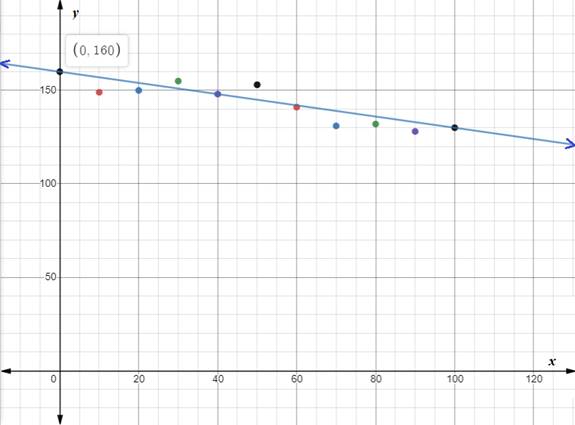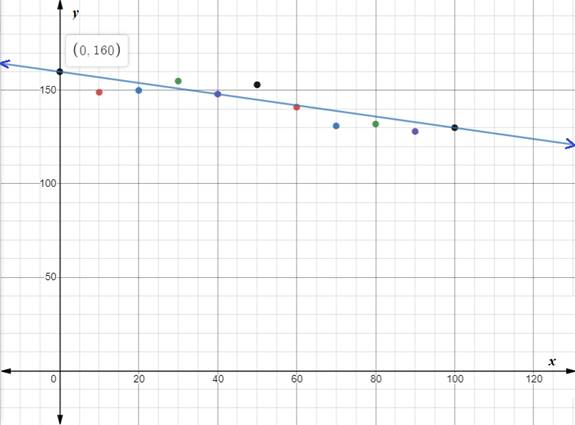
Concept explainers
a.
To make:
A
a.
Answer to Problem 33E
The line of best fit would look like:

Explanation of Solution
Given:
The table below shows the men’s winning timesin the Boston Marathon for every tenth year from 1900 to 2000. In the table, x represents the number of years since 1900, and y represents the corresponding winning time (to the nearest minute).

Calculation:
First of all, we will write our given data as ordered pairs
Now we will plotour given values on coordinate plane and draw a line of best fit as shown below:

b.
To write:
An equation for the line of best fit.
b.
Answer to Problem 33E
The equation for the line of the best fit would be
Explanation of Solution
Given:
The table below shows the men’s winning times in the Boston Marathon for every tenth year from 1900 to 2000. In the table, x represents the number of years since 1900, and y represents the corresponding winning time (to the nearest minute).

Calculation:
First of all, we will find slope of line passing through point (0,160) and (100,130) as:
Now we will use slope-intercept form to write our equation as:
Therefore, the equation for the line of the best fit would be
c.
To predict:
The men’s winning time in the Boston Marathon for the year 2010.
c.
Answer to Problem 33E
Men’s winning time in the Boston Marathon for the year 2010would be 127 minutes.
Explanation of Solution
Given:
The table below shows the men’s winning times in the Boston Marathon for every tenth year from 1900 to 2000. In the table, x represents the number of years since 1900, and y represents the corresponding winning time (to the nearest minute).

Calculation:
To predict men’s winning time in the Boston Marathon for the year 2010, we will substitute
Therefore, men’s winning time in the Boston Marathon for the year 2010 would be 127 minutes.
d.
Do you think your equation will accurately predict winning times far into the future? Explain your reasoning.
d.
Answer to Problem 33E
The equation will not accurately predict winning times far into the future.
Explanation of Solution
Given:
The table below shows the men’s winning times in the Boston Marathon for every tenth year from 1900 to 2000. In the table, x represents the number of years since 1900, and y represents the corresponding winning time (to the nearest minute).

Calculation:
The line of best fit is for our given data. The slope of the line is negative, so as the x values will increase the value of y will approach zero. Our equation for the line of best fit can predict winning times close to year 2000.
Since we cannot expect all data points to fall on the line of best fit, therefore, the equation will not accurately predict winning times far into the future.
Chapter 8 Solutions
Holt Mcdougal Larson Pre-algebra: Student Edition 2012
Additional Math Textbook Solutions
Introductory Statistics
College Algebra (7th Edition)
Precalculus
Basic Business Statistics, Student Value Edition
Calculus: Early Transcendentals (2nd Edition)
A Problem Solving Approach To Mathematics For Elementary School Teachers (13th Edition)
- Please use the infinite series formula and specify how you did each step. Thank you.arrow_forward8) Solve the given system using the Gaussian Elimination process. 2x8y = 3 (-6x+24y = −6arrow_forward7) Solve the given system using the Gaussian Elimination process. (5x-4y = 34 (2x - 2y = 14arrow_forward
- 33 (a) (b) Let A(t) = = et 0 0 0 cos(t) sin(t) 0-sin(t) cos(t)) For any fixed tЄR, find det(A(t)). Show that the matrix A(t) is invertible for any tЄ R, and find the inverse (A(t))¹.arrow_forwardUse the infinite geometric sum to convert .258 (the 58 is recurring, so there is a bar over it) to a ratio of two integers. Please go over the full problem, specifying how you found r. Thank you.arrow_forwardH.w: Find the Eigen vectors for the largest Eigen value of the system X1+ +2x3=0 3x1-2x2+x3=0 4x1+ +3x3=0arrow_forward
- need help with 5 and 6 pleasearrow_forward1) Given matrix A below, answer the following questions: a) What is the order of the matrix? b) What is the element a13? c) What is the element a₁₁? 4 -1arrow_forward[25 points] Given the vector let v = ER² and the collection of vectors ε = E-{)·()}-{☹) (9)} = {(A)·(9)}· B: = and C = · {(6)·(})}· answer the following question. (a) (b) (c) (d) (e) verify Verify is a basis for R² and find the coordinate [] of under ε. Verify B is a basis for R2 and find the coordinate []B of ʊ Verify C is a basis for R2 and find the coordinate []c of under ε. under ε. Find the change-of-basis matrix [I]+B from basis B to basis ε, and EE+BUB Find the change-of-basis matrix [I]B+ε from basis Ɛ to basis B, and verify [U]B= [] B+EVEarrow_forward
- Explain the following terms | (a) linear span (b) dimension of vector space (c) linearly independent (d) linearly dependent (e) rank of matrix Aarrow_forward3. Let u = 3/5 √ = and = -4/5 -() Define V span{ū, }. (a) (b) (c) Show that {u, } is orthonormal and forms a basis for V. Explicitly compute Projy w. Explicitly give a non-zero vector in V+.arrow_forwardIs 1.1 0.65 -3.4 0.23 0.4 -0.44 a basis for R3? You must explain your answer 0arrow_forward
 Algebra and Trigonometry (6th Edition)AlgebraISBN:9780134463216Author:Robert F. BlitzerPublisher:PEARSON
Algebra and Trigonometry (6th Edition)AlgebraISBN:9780134463216Author:Robert F. BlitzerPublisher:PEARSON Contemporary Abstract AlgebraAlgebraISBN:9781305657960Author:Joseph GallianPublisher:Cengage Learning
Contemporary Abstract AlgebraAlgebraISBN:9781305657960Author:Joseph GallianPublisher:Cengage Learning Linear Algebra: A Modern IntroductionAlgebraISBN:9781285463247Author:David PoolePublisher:Cengage Learning
Linear Algebra: A Modern IntroductionAlgebraISBN:9781285463247Author:David PoolePublisher:Cengage Learning Algebra And Trigonometry (11th Edition)AlgebraISBN:9780135163078Author:Michael SullivanPublisher:PEARSON
Algebra And Trigonometry (11th Edition)AlgebraISBN:9780135163078Author:Michael SullivanPublisher:PEARSON Introduction to Linear Algebra, Fifth EditionAlgebraISBN:9780980232776Author:Gilbert StrangPublisher:Wellesley-Cambridge Press
Introduction to Linear Algebra, Fifth EditionAlgebraISBN:9780980232776Author:Gilbert StrangPublisher:Wellesley-Cambridge Press College Algebra (Collegiate Math)AlgebraISBN:9780077836344Author:Julie Miller, Donna GerkenPublisher:McGraw-Hill Education
College Algebra (Collegiate Math)AlgebraISBN:9780077836344Author:Julie Miller, Donna GerkenPublisher:McGraw-Hill Education





